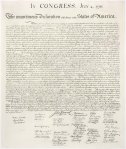The heat in the State House in Philadelphia that July had to have been unbearable. The men who had gathered there to determine the fate of the thirteen American colonies had to choose between sweltering in an enclosed room or opening the windows and subsequently gagging from the stench of the tanneries behind the hall. Philadelphia was a miserable place during the summer and residents who could afford to do so, escaped the city and retired to homes in the country. These dedicated men agreed to forgo creature comforts to help create a government for the struggling rebellion.
Five men had been charged by the Second Continental Congress to come up with a protest to send to King George in England that miserable summer. They are men of legend; John Adams of Massachusetts, Roger Sherman from Connecticut, Benjamin Franklin of Pennsylvania, Robert R. Livingston from New York and Thomas Jefferson from Virginia. Two would go on to become Presidents of the United States. One, Franklin, was in his seventies yet he would return again to the State House in 1787 to lend his wisdom to the drafting of the Constitution of the United States. It was Jefferson who drafted the original document that was modified by Adams and Franklin before being submitted to Congress on July 1, 1776. Minor modifications were made and on July 4, 1776, the Declaration of Independence was approved.
Fifty-six men eventually signed that document, but not on that July night, as is popularly depicted, but they did sign, putting their names to a document that would have gotten them all killed, had America lost the war. You’ve got to understand that victory that summer of 1776 was far from certain. The Battles of Trenton and Saratoga, where Americans delivered their first real poundings to the British army, were still to come. Many of the signers suffered tremendously for supporting the resolution for independence that had first been proposed by Richard Henry Lee of Virginia back on June 7th. John Hancock, according to legend, signed his name big enough for the king to read without needing spectacles.
What they agreed to had never been done before. Never in history had even one colony successfully wrenched away from their governing country. What these members of the Second Continental Congress agreed to do was unthinkable; they proposed to unite thirteen colonies against the only governmental authority any of them had known and they proposed to continue to put their trust in a planter from Virginia named George Washington who had little military experience and had, as of yet, delivered no true victory. Benjamin Franklin is purported to have told them, “we shall hang together or assuredly we shall all hang separately.”
The closing paragraph of the Declaration of Independence sums up what these men demanded of King George. Have you ever read it? Take a look:
“We, therefore, the Representatives of the united States of America, in General Congress, Assembled, appealing to the Supreme Judge of the world for the rectitude of our intentions, do, in the Name, and by Authority of the good People of these Colonies, solemnly publish and declare, That these United Colonies are, and of Right ought to be Free and Independent States; that they are Absolved from all Allegiance to the British Crown, and that all political connection between them and the State of Great Britain, is and ought to be totally dissolved; and that as Free and Independent States, they have full Power to levy War, conclude Peace, contract Alliances, establish Commerce, and to do all other Acts and Things which Independent States may of right do. And for the support of this Declaration, with a firm reliance on the protection of divine Providence, we mutually pledge to each other our Lives, our Fortunes and our sacred Honor.”
As a writer and a historian and more importantly, as an American, Gentlemen, I salute you.
Celebrate the fourth of July by reading the Declaration of Independence. Read it together. Read it and think of those brave men who gathered in Philadelphia and of the women who supported them by keeping their farms and businesses running. Read it and celebrate a document without equal and think for once that you don’t have to be a Conservative or a progressive to appreciate it or benefit from it.
You can read more about the Declaration of Independence at the National Archives website:
http://www.archives.gov/exhibits/charters/declaration.html
The complete transcript of the declaration can be found here:
http://www.archives.gov/exhibits/charters/declaration_transcript.html
If you want to read more about the signers of the declaration, visit the USHISTORY.ORG website:
http://www.ushistory.org/declaration/signers/index.htm
Jeriann Lane Fisher
Blogger, Historian, American.
